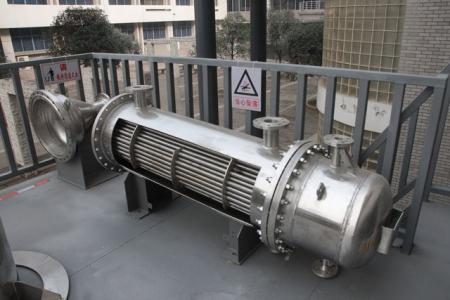Contact us
contact us
Adrress:38 Luojin Avenue, Northwest Industrial Park, Daye Economic Development Zone, Hubei Province, China
Phone:+86(0714)8755606

General introduction of heat exchanger industry
Heat exchanger is a device which transfers heat between two or more fluids with different temperatures, also known as heat exchanger and heat exchange equipment. The main function of heat exchanger is to transfer heat from the fluid with higher temperature to the fluid with lower temperature in industrial production, so that the temperature of the fluid can meet the requirements of process conditions. Heat exchanger is widely used in petroleum, chemical industry, electric power, metallurgy, ship, machinery, HVAC, food, pharmaceutical, aviation, environmental protection, urban heating and other industrial fields. Heat exchanger is a device which transfers part of heat of heat liquid to cold liquid, also known as heat exchanger. Heat exchanger is a general equipment in chemical industry, petroleum, steel, automobile, food and many other industrial sectors, and plays an important role in production. Especially in chemical production, heat exchanger can be used as heater, cooler, condenser, evaporator and reboiler.
1.1 overview of heat exchanger industry
Heat exchanger belongs to non-standard equipment. In different application fields, there are obvious differences in working environment, working condition characteristics and design parameters; even in the same industry or different sections of the same industry, the requirements of users for equipment are also different. So the heat exchanger industry business model also mainly according to the technical requirements of the user personalized design and manufacturing, to sell and order production.
Heat exchanger equipment is a large industrial energy consumption and water consumption household. According to statistics, the energy consumption of heat exchanger equipment accounts for 13% to 15% of industrial energy. The industrial cooling water consumption in China accounts for about 80% of the industrial water consumption, and the water intake accounts for 30% - 40% of the total industrial water intake. The water intake of eight industries, such as thermal power generation, steel, petroleum, petrochemical, chemical industry, paper making, textile, non-ferrous metals (5001.80, -29.580, -0.59%), food and fermentation accounts for about 60% of the industrial water intake of zygomatic Oh; the development of high efficiency cooling and water saving technology is the key point of industrial water saving.
According to the statistics of the world bank, China's GDP of US $100million consumed 559700 tons of standard oil in 2007, which is about 5.63% of Germany's GDP, 4.77 times of Japan, 3.36 times of the United States, 1.16 times of India and 2.75 times of the world average. Therefore, the task of energy saving and consumption reduction in China's industrial field is urgent and arduous. As a large consumer of water consumption, water saving and energy saving are the key points of the development of cooling (condensing) equipment in the future.
At present, China is short of energy and water resources, forcing the state to vigorously implement policies such as resource saving and clean production, and greatly increase the application requirements of high efficiency, water saving, energy saving and environmental protection cooling (condensation) equipment in the industrial field.
1.2 technical development of heat exchanger industry
With the continuous change of the requirements of cooling (coagulation) equipment in various industrial fields, the development of cooling (condensation) technology has experienced three stages: the first stage is to solve the problem of whether heat exchange can be realized; the second stage aims to improve the cooling (condensation) efficiency, mainly the research on heat transfer process and the improvement of heat exchange parts; The third stage emphasizes the optimization of the production cost, operation cost, environmental consumption cost and the cooling (coagulation) effect.
In the world, although shell and tube heat exchanger still occupies the dominant position, the competitiveness of various plate heat exchangers is gradually rising. The development trend of the world heat exchanger industry in terms of products and technologies mainly shows as large-scale, high efficiency and energy-saving. In addition, the development and application of new materials, the renewal and replacement of product technology and the fine differentiation of products in different application fields are also the trend of the industry.
1.3 classification of heat exchanger
With the rapid development of energy saving technology, there are more and more types of heat exchangers. New heat exchangers with new structures and materials are emerging. The products of heat exchanger are different for different temperature, pressure, medium and working condition. The heat exchanger products can be classified according to the structure characteristics of heat transfer surface, whether they belong to pressure vessel, heat transfer process, materials used, purpose, structure characteristics of heat transfer surface, whether they belong to pressure vessel, heat transfer process, materials used, use, compactness of heat transfer surface, process conditions and phase state of fluid.


 Home
Home
